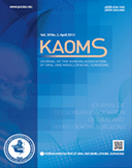Journal of the Korean Association of Oral and Maxillofacial Surgeons
- P-ISSN2234-7550
- E-ISSN2234-5930
- SCOPUS, KCI, ESCI
 ISSN : 2234-7550
ISSN : 2234-7550
Comparison of temporomandibular disorders between menopausal and non-menopausal women
Masumeh Taghva (Department of Prosthodontics and Postgraduate Student of Orthodontics, School of Dentistry, Shiraz, Iran)
Moslem Babooie (Department of Prosthodontics and Postgraduate Student of Orthodontics, School of Dentistry, Shiraz, Iran)
Abstract
Objectives: Hormonal changes during menopause alter a woman’s susceptibility to some disorders. Information regarding the prevalence of temporomandibular disorder (TMD) in menopausal women is limited in the literature. In this study, the prevalence and severity ofTMDs were compared between menopausal and non-menopausal women. Materials and Methods: The study included 140 women (69 premenopausal and 71 postmenopausal) 45 to 55 years of age that wereexamined in Shiraz Dental School, Shiraz in Iran. The Helkimo clinical dysfunction index (Di) was used to evaluate temporoandibular joint (TMJ) dysfunction. The data were analyzed using chi-square and Fisher’s exact tests. Results: Occurrence of TMD was significantly higher in menopausal than non-menopausal women (P<0.001). All the TMD criteria based on Helkimo Di except range of mandibular movement were significantly more common in menopausal women. The range of mandibular movement was not significantly different between menopausal and non-menopausal women (P=0.178). Conclusion: The results from this study show that TMD can be considered more common and severe in menopausal than non-menopausal women. This finding indicates that, similar to other conditions in menopausal women such as arthritis and osteoporosis, TMD should be taken into consideration by dental and medical professionals.
- keywords
- Temporomandibular joint disorders, Menopause, Prevalence
- Downloaded
- Viewed
- 0KCI Citations
- 0WOS Citations